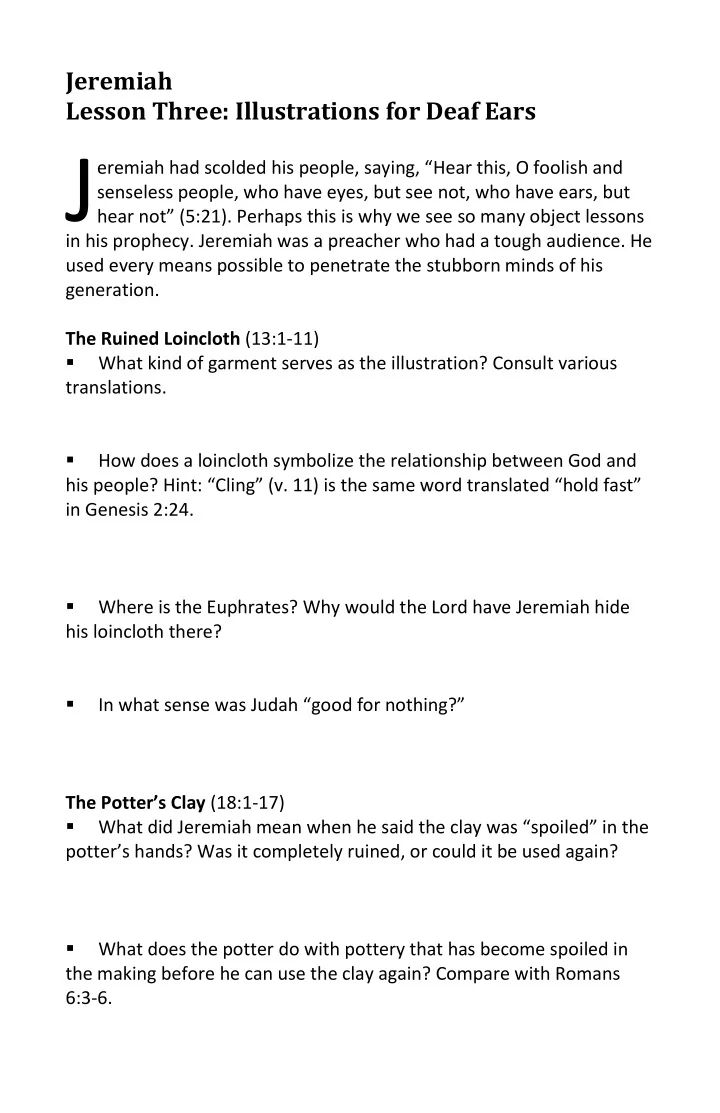

Jeremiah Lesson Three: Illustrations for Deaf Ears J eremiah had scolded his people, saying, “ Hear this, O foolish and senseless people, who have eyes, but see not, who have ears, but hear not” (5:21). Perhaps this is why we see so many object lessons in his prophecy. Jeremiah was a preacher who had a tough audience. He used every means possible to penetrate the stubborn minds of his generation. The Ruined Loincloth (13:1-11) What kind of garment serves as the illustration? Consult various translations. How does a loincloth symbolize the relationship between God and his people? Hint: “Cling” (v. 11) is the same word translated “hold fast” in Genesis 2:24. Where is the Euphrates? Why would the Lord have Jeremiah hide his loincloth there? In what sen se was Judah “good for nothing?” The Potter’s Clay (18:1-17) What did Jeremiah mean when he said the clay was “spoiled” in the potter’s hands? Was it completely ruined, or could it be used again? What does the potter do with pottery that has become spoiled in the making before he can use the clay again? Compare with Romans 6:3-6.
How is the potter a perfect analogy to the Lord? The Broken Flask (19:1-12) What was the sign and its significance? What was going on in Topheth? Who ended these atrocities and how did he do it? (see 2 Kings 23:10). How do people get to the point of doing the kinds of things the Jews were doing in Topheth? Any modern day parallels? The sins of Topheth were according to what God did not command or decree (19:5; cf. 7:31; Lev. 10:1-2). What does this tell us about how we should interpret God’s Word? Is it okay to do something just because “God didn’t say we can’t do it”? The Two Baskets of Figs (24:1-10) What wa s the sign and the significance? Who are the “good figs?” Who are the “bad?” Is there any reason why the captives were more pleasing to God than those who stayed behind in Judah? The Yoke (27:1-11) What is a “yoke?”
Why do you think the nations in verse 3 had come to Zedekiah in Jerusalem? What was Jeremiah’s message here? In what sense was Nebuchadnezzar God’s “servant?” (v. 6; cf. 25:9, 11; 43:10). How does Jeremiah’s message compare with Jesus’ in Matthew 11:28-30? Any similarities? Any differences? The Purchased Field (32:6-25) Why was Anathoth important to Jeremiah? (see 1:1-3). Where was Anathoth? What was striking about a person buying real estate in that area? Why did Jeremiah’s investment assure p eople of faith in that day? How is this a positive message? Discuss its relationship to Ephesians 2:4-7 and Revelation 21:1-5. The Large Stones (48:8-13) Where is Tahpanhes? What is the setting of this illustration? Why did Jeremiah hide stones there? Would the Jews be safe in Egypt? Can man run from God? (cf. Jer. 23:23-24; Heb. 4:13).
The Sunken Scroll (51:59-64) Who actually conducted this illustration? How might this have been hard for Jeremiah? How does this lesson balance what we read about Nebuchadnezzar in 27:6? Conclusion Why do you think Jeremiah used object lessons? Do you think they were effective? Would they be effective today? Readings for Meditation “Cartooning is preaching.” -Charles Schutz, creator of Peanuts “ I want to ban the illustration that doesn't make sense — that violates the laws of nature or common sense: ‘ That massive 18th-century ship stopped at the exact point where the little girls were lost at sea and there, they wep t and wrote the following poem.’ It is highly unlikely that a ship in the 18th century could find an exact spot in the sea. Every gps- using listener in the audience dismisses the story as rubbish.” -Richard Allen Farmer “Illustrations are the lifeblood of preaching. They take an ordinary truth and make it extraordinary. The word illustration means ‘to throw light on a subject.’ Effective illustrations are like footlights that help us see the actors on the stage. But if a footlight shines in the audience's eyes, it blinds them to what they ought to see. A story told for its own sake may entertain or amuse, but if it fails to throw light on the truth preached, it is not an ‘illustration’ but simply a story. It gets in the way. In fact, the better the story, the more distracting it will likely be.” -Haddon Robinson
Recommend
More recommend